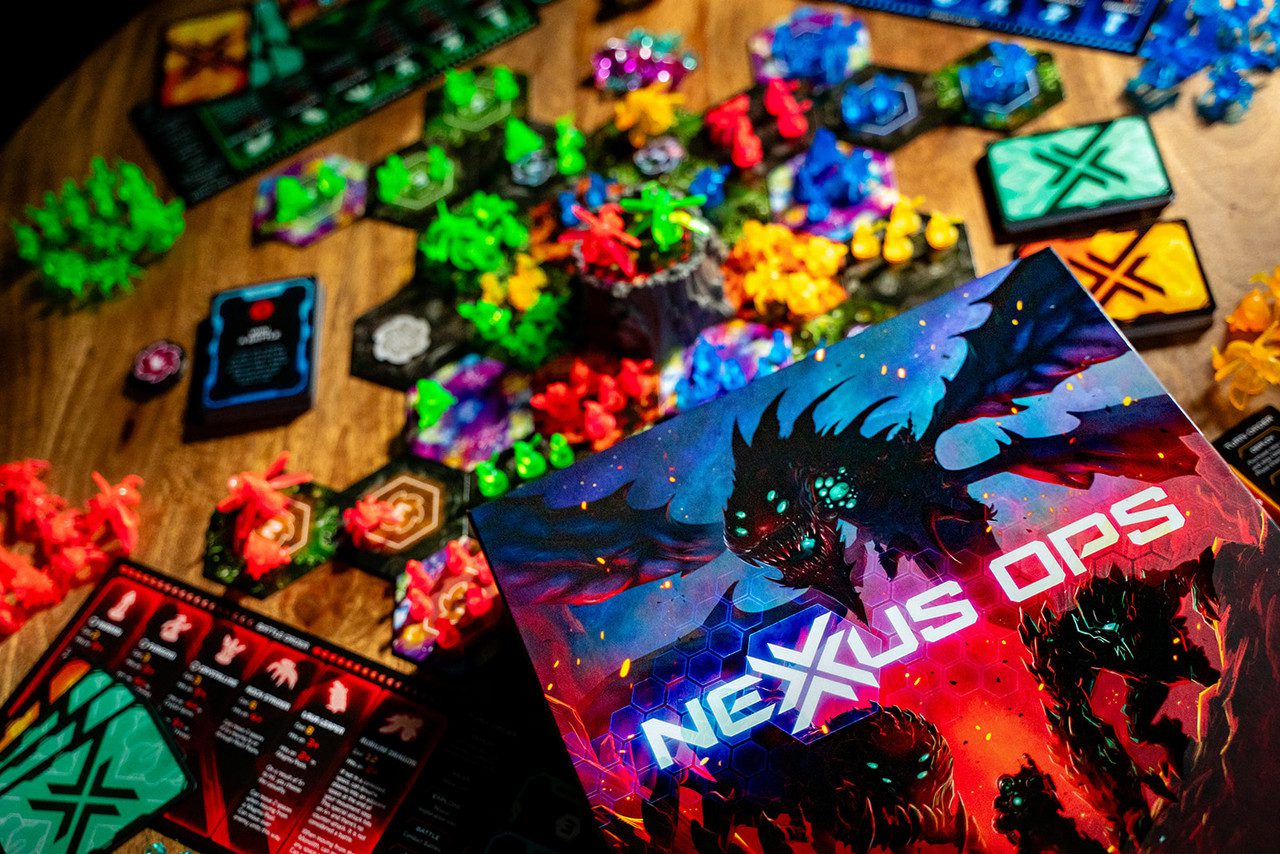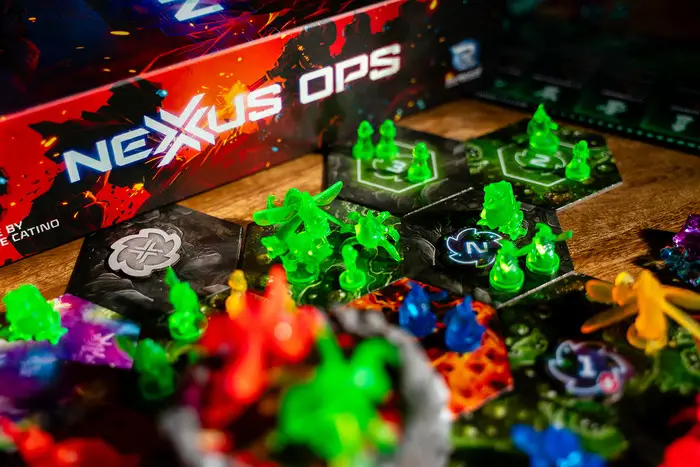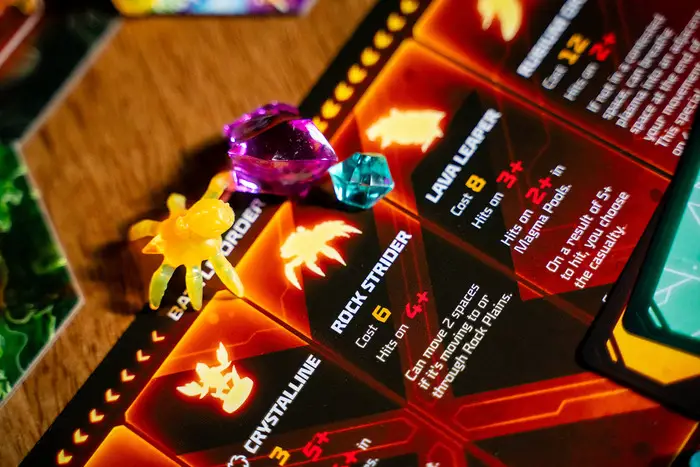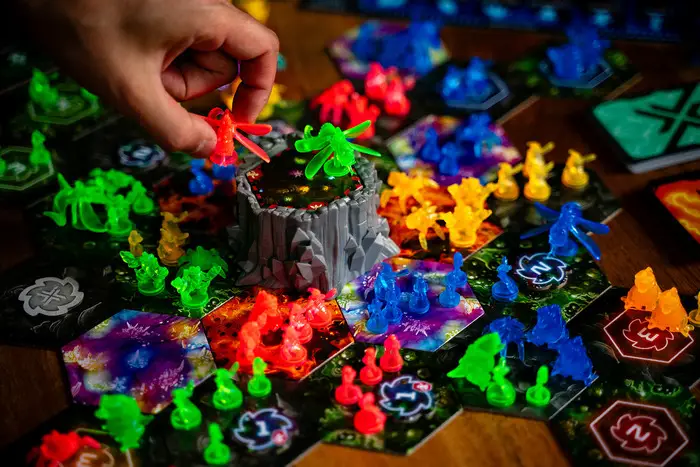Board game classics are constantly being reinvented, in ways big and small. For some games that means a total overhaul of the rules to fit a new audience. For others, it’s a simple reskin to cash in on a tie-in. But for Renegade Game Studios’ new edition of Nexus Ops, an Avalon Hill game from 2005 last published by Fantasy Flight, a more delicate approach was used. Not delicate in an aesthetic sense, oh no, because this is a bright and VIBRANT new version of the game with pieces that glow even before you add a black light. Delicate in the sense that they took what wasn’t broke and just…added to it. A few new alternate rules, a visual redesign, and some killer box art was all that was needed to keep the game chugging just in time for its 20th Anniversary next year. Released as part of Renegade’s new deal with Hasbro, I got a chance to check out Nexus Ops at Gen Con and then at home where the glowingly gorgeous sci-fi game really shined.
What’s In The Box?

- 164 Plastic “Glow” Figures
- 4 Player Boards
- 108 Cards (Mission, Secret Mission, Energize)
- 16 Game Board Tiles
- 1 Double-Sided Monolith Tile
- 1 Plastic 3D Monolith
- 24 Exploration Tokens
- 70 Rubium gems
- 1 First Player Token
- 6 Dice
- 1 Rulebook
The biggest change in Renegade’s re-release of Nexus Ops is the glow-up (pun somewhat intended). While each edition of the game has improved on the visual style, Renegade has raised the bar with way more distinctive tiles replacing the sludgey Fantasy Flight art and with much more vivid and literally glowing pieces. Yes, these things glow under a black light and while that might not come up MUCH in plays of this game…it’s still super cool. Really the whole thing feels like someone took the previous edition and cranked the saturation up to eleven. For a game trading in over-the-top sci-fi action it works a treat. And of course the Monolith in the middle, previously cardboard, is a Heroscape-worthy hunk of plastic that helps give the battlefield a fun 3D feel.
How’s It Play?

Fans of the original Nexus Ops will be familiar with the basic gameplay which hasn’t changed since 2005. Each player represents a corporation vying for valuable Rubium on a distant planet. At your disposal for the sci-fi battle ahead are the strange aliens that live on the planet: Fungoids, Crystallines, Rock Striders, Lava Leapers, and the powerful Rubium Dragons. Your goal is to complete 12 missions (secret or otherwise) around the planet while gathering resources, taking territory, and defeating your opponents in battle.
Play occurs across six phases. Yu’ll deploy your units on the board and then move them one hex at a time to the different spaces that make up the board. These spaces and shapes are randomized each time, as are the Exploration Tokens on each space. In the Explore phase, you flip the token on your space to either gain a unit, gain a mine (valuable for victory) or both.
When more than one player occupies a space, this is a “contested” space and therefore you must BATTLE. Combat is a fairly straightforward roll of the dice, with each player getting dice equal to their units in battle. A successful attack is one where you roll higher than the “hits on” number (it’s quite Warhammer Jr.). Each piece also has bonuses to hit in certain areas (Fungoids gets +4 in the Liquifungus Forest, Leave Leapers get +2 in Magma Pools, etc.) and they also have some unique movement rules.

Battling is the only way to play your Mission cards, which is how you actually get victory points. Basic Missions get you a point just for winning a battle, but from there you can score higher by controlling territory, battling in the right way, or pulling off certain harder achievements. Losing a battle isn’t a total loss as its one of only two ways to get Energize cards, the other being by controlling the central Monolith at the end of your turn. Energize cards are played in different phases and give you powerful one-time abilities to boost your troops and make things more interesting. These won’t turn the tide completely, but they’re a great way to keep balance as things go on.
The Verdict?

Nexus Ops is a fabulous little entrypoint for wargaming and might be the lightest version of this style of game I’ve ever played. Games like Risk or Stratego are often people’s first time with a strategy battle game, but both aren’t actually as accessible as they seem. The colorful theme, simple battles, and more condensed player board means more time battling for dominance and less time turtling in Australia. It’s also a hell of a lot quicker than those games will still offering plenty of ways to try different strategies.
The thing that will most likely stick in the craw of hardcore strategy players is the randomized nature of the game, which for my money is also what makes the game even better. Everything changes from game to game: the bonuses on each space change each game, the type of each space, the missions and cards. It means that you can almost never play the same game of Nexus Ops twice. And if you somehow do, you can try out some of the alternate rules that can change up the goals of the game, adds in new tokens, or even gives you alternate units to use. You can even totally invert the Monolith to form The Vortex, an alien storm that can energize and destroy your armies in equal measure.
If you’re not a fan of big strategy but want to still have some fun fighting your friends, Nexus Ops is a great option for that. And even if you’re a strategy snob this is a great gateway game to get your friends hooked before you move them to the hard stuff (or if you don’t have 6 hours to kill playing one game).
You can pick up Nexus Ops directly from Renegade, Amazon, or at your FLGS at an MSRP of $65.00.
Images via Renegade Game Studios
Have strong thoughts about this piece you need to share? Or maybe there’s something else on your mind you’re wanting to talk about with fellow Fandomentals? Head on over to our Community server to join in the conversation!

